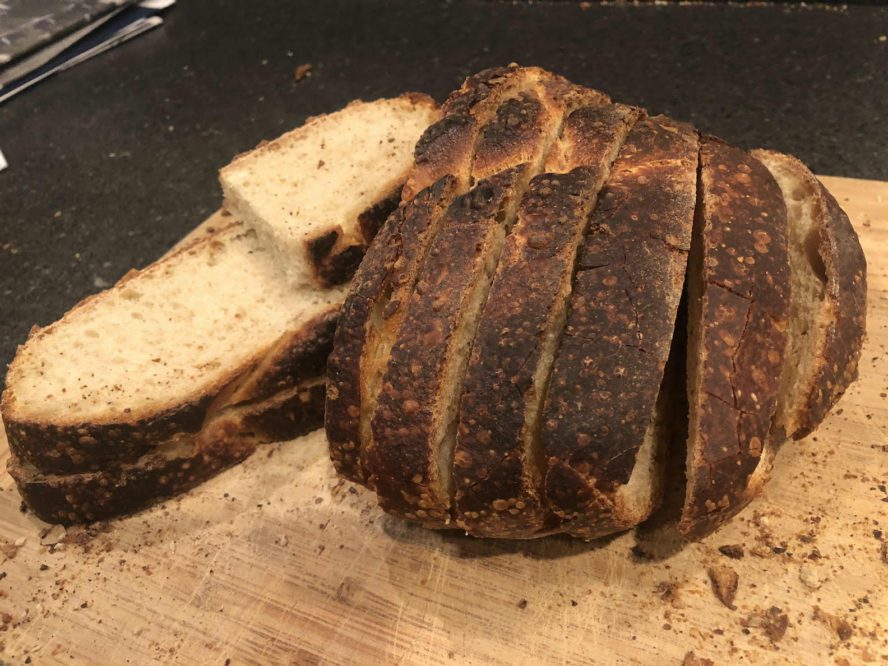 It all started because the San Francisco Sourdough bread we always got at Whole Foods lost its connection to everybody’s favorite city. The loaves we purchased weekly began looking and tasting more like Truck Stop White bread, or the too soft mass-produced square loaves of our childhoods. Unable to resist an attempt to solve this problem for the bakery department, my husband and I explored possible explanations for this situation. We decided they might be slicing and packaging the bread too soon after it’s baked in order to meet Covid sanitation standards. In pre-Covid days the crisp round loaves were displayed on an open shelf. Using a sheet of the waxed papers provided, the customer would hand their selected loaf to the attendant for them to slice. Then, after being sliced, the loaf would be placed in a plastic sack. The crust stayed crisp and the center tasty and firm.
It all started because the San Francisco Sourdough bread we always got at Whole Foods lost its connection to everybody’s favorite city. The loaves we purchased weekly began looking and tasting more like Truck Stop White bread, or the too soft mass-produced square loaves of our childhoods. Unable to resist an attempt to solve this problem for the bakery department, my husband and I explored possible explanations for this situation. We decided they might be slicing and packaging the bread too soon after it’s baked in order to meet Covid sanitation standards. In pre-Covid days the crisp round loaves were displayed on an open shelf. Using a sheet of the waxed papers provided, the customer would hand their selected loaf to the attendant for them to slice. Then, after being sliced, the loaf would be placed in a plastic sack. The crust stayed crisp and the center tasty and firm.
I wasn’t present when my husband offered our idea to the Whole Foods bakery employee, but I was not surprised that her reaction was less than enthusiastic. I could picture her slightly rolling her eyes, hear her barely audible “take a breath sigh,” even imagine what she might have said to herself after he left the counter. “Just what I need, some genius who has a better idea of how I should be doing my job.”
I did get a better idea. Like many of you have done during the pandemic, when products you had relied on were not available, and bread baking became the thing to do. In March there were so many bread bakers we were at risk of running out of flour. In April, yeast was a scare commodity at many grocery stores across the country. And almost from the beginning of the pandemic, books and youtube videos on baking bread, especially sourdough, become hot items. As I began ordering holiday gifts on-line for family members, I ordered myself a sourdough starter and supplies to begin my own journey learning how to bake, in my very own kitchen, sourdough bread.
Why sourdough? In my eating program (I don’t consider it a diet, but more a way of life) I am not supposed to eat bread. But if I do, it must be sourdough. The reason for this is that gluten in bread is not easy to digest, in spite of bread’s reputation as “the Staff of Life.” In my case, if I get too much gluten it bonds with something in my body that causes pain in my arthritic big toe, the site of an old dance injury. The good bugs present in the sourdough starter predigest the gluten and the lactic acid makes the vitamins and minerals in the flour more available to the body by helping to neutralize the phytates in flour that would interfere with their absorption. That’s how we became good customers at Whole Foods bakery. Making sourdough bread is complicated and it’s hard to find almost anywhere else in our neighborhood.
I welcomed my 100% Organic Dehydrated Heirloom Starter a couple of days after Christmas. I was a bit taken back by the description of this item as “your newest lifelong companion,” but encouraged by the promise that, once I started a regular feeding schedule, my sourdough starter will last a lifetime. “Feed it and it will feed you.” To date I have made two, very different but delicious loaves. Full disclosure–I threw the first batch of dough out. True to the faults in my personality, I rushed the process, and the starter wasn’t ready.
Besides the tempting alure of the odor of freshly baking bread throughout the house and its delicious taste as we consume it, I’ve wondered why the baking of sourdough bread is such a popular rewarding enterprise in these tough times. Perhaps as the whole world suffers from the proliferation of an unseen bad organism and its interruption of our lives across the globe, it’s especially rewarding to learn how to culture and utilize unseen good bugs and experience their support and nourishment in our lives.
Love to hear what you’ve been learning to do during these tough times.
Sheila

